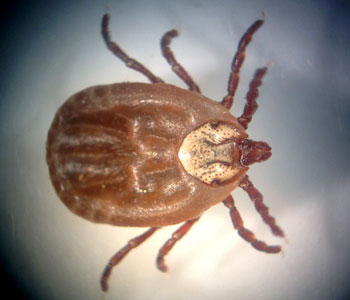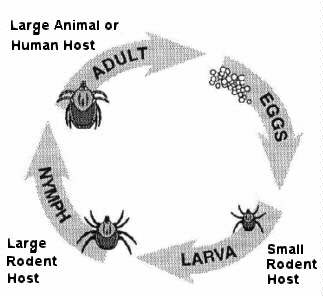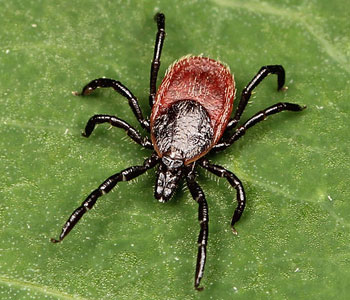Ticks in British Columbia
There are more than 20 species of ticks in British Columbia, but only three species normally bite humans. Although the bites are sometimes painful and slow healing, there is little danger of disease as long as they are removed promptly.
Adult ticks have eight legs, unlike insects, which have six. Ticks cannot jump or fly and do not drop from trees. They require blood as a source of protein for growth and egg development. A few simple precautions will decrease the likelihood of tick bites.
Learn more about ticks that are commonly found in B.C., how to remove attached ticks, and how to prevent tick bites:
- The Rocky Mountain Wood Tick
- The Western Black-legged Tick
- Other Ticks
- Removal of Attached Ticks
- Personal Protection
- Area Tick Control
The Rocky Mountain Wood Tick (Dermacentor andersoni)
In British Columbia, this tick occurs in the interior dry belt from the United States border north as far as Williams Lake and eastward into Alberta. It is not found west of the Coast Range mountains. The Rocky Mountain wood tick is a three-host tick, a new host being sought for each one of its three feedings which occur over a period of 1 to 3 years. Usually rodents and other small animals serve for the first two feedings, and large animals such as deer, cattle, dogs, sheep and humans serve as the host for the last feeding. This tick is most frequently encountered between March and June, usually in open, rocky areas.
 |
Rocky mountain wood tick female
|
The adult female is reddish-brown with a white "shield" near the front, and the similarly sized male is mottled-grey in colour. Both sexes "quest" for hosts by waiting near the top of grass and low shrubs, readily attaching to passing people or animals that brush against them. Once on a host they climb upwards, giving rise to the erroneous observation that they have dropped from trees. If the quest is unsuccessful, the ticks return to the ground until the next spring. Ticks successful in finding a host attach their mouthparts to the skin by means of a rapidly hardening excretion. Tick bites usually don’t hurt, as an anesthetic is delivered in saliva, which prevents rapid detection. Feeding females quickly increase in size, excreting a mass of black bloodwaste during the process. When they reach the size of a swollen raisin, which can take several days, they drop to the ground and, after several weeks, lays a few thousand eggs and die.
Although the Rocky Mountain wood tick is a known carrier of Rocky Mountain spotted fever, tularemia, and Colorado tick fever in the United States, these diseases rarely occur in Canada. However, in British Columbia and western USA this tick causes tick paralysis in mammals, including humans and livestock, which is caused by a neurotoxin in tick saliva.
Tick paralysis is characterized by increasing uncoordination and eventual collapse. The first symptoms, usually a numbness in the feet and legs causing difficulty in walking and standing, occur after a female tick has been feeding for about 5 days. The hands and arms are usually affected next and there is often partial paralysis of the throat and tongue muscles, resulting in difficulty swallowing and speaking. There is little pain and usually no fever. There is no known antidote for tick paralysis, but complete recovery occurs when the tick is removed if paralysis has not progressed too far. Death may occur if the tick is overlooked. The nature of the toxin, likely secreted by the female during feeding, is not known.
 |
Life Cycle of Dermacentor andersoni |
The Western Black-legged Tick (Ixodes pacificus)
The Western Black-legged tick is very common during the spring and early summer. It occurs on vegetation in warm, moist areas on Vancouver Island, the Gulf Islands, and along the mainland coast between the United States border and Powell River. Its eastward range extends along the Fraser River to Yale and north to Boston Bar.
The red and black females and smaller black males attach to humans, deer, cats and dogs, becoming grey and bean-like in size as they feed. The bite is often painful and may result in a slow-healing ulcer. This tick does not cause paralysis; however, it is a carrier of the microorganism responsible for Lyme disease in North America. The organism which causes Lyme Disease, Borrelia burgdorferi, has been found in ticks collected from many areas of B.C., and health authorities now believe that Lyme Disease carrying ticks may be present throughout the province. For more information on Lyme Disease, see the B.C. Centre for Disease Control web site.
 |
Western black-legged tick (Ixodes pacificus) Photo: Creative Commons, by Ryan Kaldari, licensed under CC0 1.0 |
Other Ticks
Many other British Columbia ticks feed only on a narrow range of hosts such as squirrels, rabbits, groundhogs and birds. A commonly encountered tick is the winter tick, Dermacentor albipictus, which has one generation per year, and feeds on only one host during its lifetime. It feeds on moose, deer, horses and cattle during the winter after questing for a host in the fall, and then drops in the spring to lay eggs. This tick will not feed on humans..
The brown dog tick, Rhipicephalus sanguineus, is a reddish-brown species that feeds on dogs, usually feeding around the ears and between the toes. It rarely feeds on humans. This species and its eggs may be found around cracks and baseboards in homes after dropping off a dog. This species is widely distributed globally, and can complete its life cycle indoors.
Removing Attached Ticks
Ticks can be difficult to remove, since they attach themselves to their host with small, barbed mouthparts. Ticks do not burrow under the skin. Ticks are most safely and effectively removed with tweezers using a slow and gentle pull without twisting. This will normally remove the tick with the mouthparts attached. The wound should be cleaned and treated with an antiseptic. See the BC Center for Disease control website for further detailed information on removal of ticks.
Personal Protection
The following precautions will decrease the likelihood of tick attachment.
- Wear high boots or tuck pant cuffs into socks. Tuck shirt into pants. Do not wear short pants. Application of commercial insect repellents containing diethyl toluamide (DEET) to the pants may assist in repelling ticks.
- If possible, avoid game trails or old roads overgrown or closely lined with vegetation. Tick levels may be high in areas frequented by animals.
- When resting, sit on a bare rock, a ground sheet, or a vegetation-free area instead of stretching out on vegetation.
- Make daily examinations for ticks, paying particular attention to the pubic region, the base of the skull, and the scalp. Check the backs of everyone in the group and carefully inspect any children. Clothes should be closely examined for ticks, especially near the collar, after they have been hanging overnight.
If you have the following symptoms within days or weeks after being bitten by a tick, please report them to your family doctor immediately. Tell your doctor when and where you were bitten by a tick. If possible, keep any removed ticks and take them to your doctor who may need to have the ticks identified. Ticks can be stored in any sealed container in a fridge or freezer.
- General symptoms of fever headache, muscle and joint pains, fatigue or weakness of the muscles of the face.
- Skin rash, especially one that looks like a "Bull's Eye". It may or may not be where the bite was.
- In some cases paralysis may occur. The paralysis usually starts in the feet and legs and gradually works its way up to the upper body, arms and head. This paralysis can develop from within a few hours to several days.
Area Tick Control
Elimination of ticks over large areas is not feasible. However, it is possible to significantly reduce the probability of tick bites in parks and recreation areas by concentrating control efforts on walks and trails. Removal of brush and other vegetation by mowing will reduce the number of ticks along trails or in picnic areas. Insecticides applied to ground vegetation a few feet on either side of a trail will aid in local tick control as ticks do not move far.
Updated November, 2018
